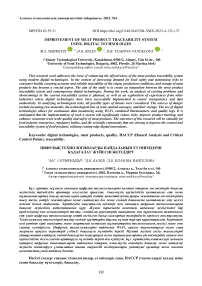Improvement of meat product traceability system using digital technologies
Автор: Serikkyzy M.S., Balev D.K., Vlahova-vangelova D.B.
Журнал: Вестник Алматинского технологического университета @vestnik-atu
Рубрика: Технология пищевой и перерабатывающей промышленности
Статья в выпуске: 4 (142), 2023 года.
Бесплатный доступ
This research work addresses the issue of enhancing the effectiveness of the meat product traceability system using modern digital technologies. In the context of increasing demand for food safety and minimizing risks to consumer health, ensuring accurate and reliable traceability of the origin, production conditions, and storage of meat products has become a crucial aspect. The aim of the study is to create an integration between the meat product traceability system and contemporary digital technologies. During the work, an analysis of existing problems and shortcomings in the current traceability system is planned, as well as an exploration of experiences from other industries where digital technologies have been successfully implemented to ensure transparency and data authenticity. In analyzing technological risks, all possible types of threats were considered. The sources of danger include incoming raw materials, the technological line of semi-smoked sausages, and their storage. The use of digital technologies allows for continuous data monitoring using Wi-Fi, combined thermometers, and quality logs. It is anticipated that the implementation of such a system will significantly reduce risks, improve product tracking, and enhance consumer trust in the quality and safety of meat products. The outcomes of this research will be valuable for food industry enterprises, regulatory bodies, and the scientific community that are striving to improve the control and traceability system of food products, utilizing cutting-edge digital innovations.
Digital technologies, meat products, quality, haccp (hazard analysis and critical control points), traceability
Короткий адрес: https://sciup.org/140303457
IDR: 140303457 | DOI: 10.48184/2304-568X-2023-4-132-137
Список литературы Improvement of meat product traceability system using digital technologies
- Rassmotrenie izmenenii zakonodatelstva v oblasti pishchevoi promyshlennosti v Rossii i EAES [Consideration of changes in legislation in the field of food industry in Russia and the EAEU]/ Rudenko L. D., Shcherbakova A. A., Gulin V. M.// Improving the quality and safety of food products. – 2022. – рр. 209-211.
- Chen S. et al. A vision of IoT: Applications, challenges, and opportunities with china perspective //IEEE Internet of Things journal. – 2014. –V. 1. – №. 4. – рр. 349-359. https://doi.org/10.1109/JIOT.2014.2337336.
- Doinea M. et al. Internet of things based systems for food safety management //Informatica Economica. – 2015. – V. 19. – №. 1. – P. 87. http://dx.doi.org/10.12948/issn14531305/19.1.2015.08.
- M. Biegańska and W. Kozak. Contemporary technologies used for product traceability and quality control//Current Trends in Commodity Science. Challenges in Food Development and Processing, рр. 135-148, 2017.
- Liu Y. et al. An Internet-of-Things solution for food safety and quality control: A pilot project in China //Journal of Industrial Information Integration. – 2016. – V. 3. – рр. 1-7. https://doi.org/10.1016/j.jii.2016.06.0017.
- Panda S. K. Revolution of the Metaverse and Blockchain Technology //Metaverse and Immersive Technologies: An Introduction to Industrial, Business and Social Applications. – 2023. – рр. 97-125. https://doi.org/10.1002/9781394177165.ch4.
- Casino F. et al. Modeling food supply chain traceability based on blockchain technology //Ifac- Papersonline. – 2019. – V. 52. – №. 13. – рр. 2728-2733. https://doi.org/10.1016/j.ifacol.2019.11.620.
- Chen M. et al. A survey of recent developments in home M2M networks //IEEE Communications Surveys & Tutorials. – 2013. – V. 16. – №. 1. – рр. 98-114. https://doi.org/10.1109/SURV.2013.110113.00249.
- Tehnicheskiy reglament 021/2011 "O bezopasnosti pischevyih produktov" [Elektronnyiy resurs] [Technical Regulation 021 / 2011 "On food safety" [Electronic resource]: URL: https://adilet.zan.kz/rus/docs/H11T0000880 (accessed January 11, 2023).
- ISO 22000:2018 «Food safety management systems. Requirements for any organization in the food chain» [Electronic resource]: URL: https://online.zakon.kz/Document/?doc_id=39509429 &show_di=1 (accessed January 11, 2023).
- Serikkyzy M. et al. Developing a Risk Assessment Methodology for the Production of Semi- Smoked Sausages //Journal of Culinary Science & Technology. – 2023. – рр. 1-9. https://doi.org/10.1080/15428052.2022.2034695.
- Tripoli M., Schmidhuber J. Optimising traceability in trade for live animals and animal products with digital technologies //Rev. Sci. Tech. – 2020. – V. 39. – №. 1. – рp. 235-244. https://doi.org/10.20506/rst.39.1.3076.
- Azuara G., Luis Tornos J., Luis Salazar J. Improving RFID traceability systems with verifiable quality //Industrial Management & Data Systems. – 2012. – V. 112. – №. 3. – рp. 340-359. https://doi.org/10.1108/02635571211210022.
- Sander F., Semeijn J., Mahr D. The acceptance of blockchain technology in meat traceability and transparency //British Food Journal. – 2018. – V. 120. – №. 9. – рр. 2066-2079. https://doi.org/10.1108/BFJ-07-2017-0365.
- Bosona T., Gebresenbet G. Food traceability as an integral part of logistics management in food and agricultural supply chain //Food control. – 2013. – V. 33. – №. 1. – рp. 32-48. https://doi.org/10.1016/j.foodcont.2013.02.004.


